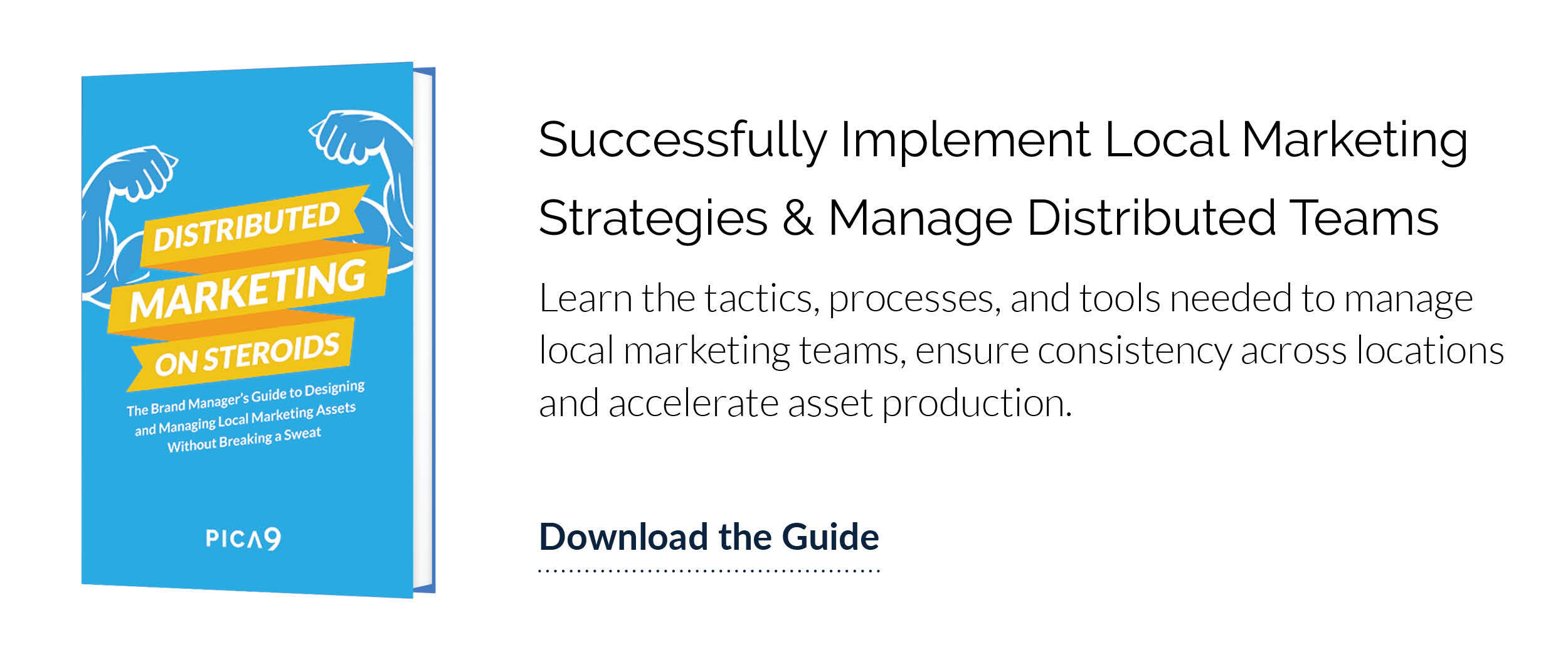In today's market of globalization and eCommerce, customers are used to getting what they want when they want it. Brands all around the world have caught on to this demand, and are expanding rapidly to meet customer demands. But with franchises, dealerships, and local outlets coming on board at exceptional rates, brand managers often face serious pressure to deliver results – often while managing hundreds of local outlets.
Studies by Fournaise group indicate that 74% of CEOs want their marketing teams to become 100% ROI-focused. While certainly a nice goal, achieving it requires heavy-duty planning and organization. When you're in the position of managing local marketing teams at a distributed brand, overcoming the challenges around resource management is not an easy task.
In this blog, you'll learn how successful distributed brand managers keep their campaigns and people organized, updated, and moving in the right direction. We'll take a look at the processes, workflows, tech, and other concepts you need to organize marketing resources and exceed your KPIs.
What Do We Mean By Marketing Resources?
When we say "marketing resources," you probably think about design files, photos, digital files, print templates, and similar marketing assets. That's certainly a large part of it, and managing these factors isn't a small task for distributed brands.
However, marketing resources also includes people and processes. In the business world, there are four categories of resources: physical, intellectual, human, and financial.
- Physical: Buildings, vehicles, hardware, and other material assets. This rarely falls under the control of distributed brand managers.
- Intellectual: Files, brand guidelines, training materials, and other collateral. The area of intellectual resources also includes your brand and any patents or trademarks. This is where "assets" come into play.
- Human: In-house marketing talent, your local affiliates, and all of your contractor/sub-contractor relationships.
- Financial: Marketing budgets and campaign funds.
Most brand managers deal with intellectual, human, and financial assets. If any three of these areas are out of alignment, your marketing strategy may not perform well. If your files are in perfect order but your humans aren't able to access them easily, you're not going to be able to move in the right direction.
The 5 Ways to Keep Marketing Resources Organized
1. Develop a Common Vocab (Ideally BEFORE You Grow)
You probably know what asset disorganization looks like. We've all seen situations where files just aren't usable. They may be stored in Dropbox or on a File Transfer Protocol (FTP) site, but no one can make any sense of them because of how the files are named and organized.
Asset organization is about having a common set of vocabulary and expectations when dealing with marketing assets.
Chances are, your brand management team and local partners are using some very different terms to describe the same things. The first step toward aligning processes requires you to define the following:
- File naming conventions and taxonomy
- Asset tagging/metadata
- Campaign and asset keywords
It's not that hard to keep your assets organized when you're working with a relatively small team of expert marketers. All you need is a point of access and standard file naming conventions. However, when you're dealing with distributed teams, you're quickly going to run into challenges.
As a brand manager, you're dealing with differences in objectives. Your local marketers need different things. There's also variation in skills and experience. What "makes sense" to your in-house designer might be too abstract for a local marketer. Developing a common set of vocabulary and expectations that works for EVERYONE is important.
2. Adopt Staging: Share/Release Assets in Stages
Local marketers need access to the right campaign assets at the right time. How do you ensure they're deploying campaigns appropriately instead of trying to update last season's assets? The solution here is staging.
Staging is the act of planning your campaigns in stages, and deploying the assets to your local affiliates with an appropriate cadence.
Staging is a challenge for every distributed brand, but it's a concept that's especially familiar to leading power sports organization Polaris Industries. Their brand management team is responsible for coordinating 100 unique sales events across 2,400 dealers in 11 countries per year.
Polaris depends on the ability to hold back new campaign assets to keep them a total secret prior to launch and use Local Marketing Automation (LMA) technology to deploy them rapidly on release. This has helped them deploy campaigns in stages straight to local affiliates, and helps them launch entire product lines or new model year releases within 7 days.
3. Align Your Workflows with Local Partners' Skills
Your head office may work in a well-defined way while your local marketers follow a completely different process. Sometimes, local affiliates have very little process at all, while others are just not on the same page. Either way, this can lead to frustration when campaign assets aren't deployed in the right order or on schedule.
A one-size-fits-all approach to creative approval isn't always best, either. Some of your local affiliates may have tons of marketing knowledge, and a history of compliant campaigns, while others struggle.
Creating a marketing workflow that is sensitive to the unique needs of your local affiliates, and technology driven, can help. The right tool for distributed marketing workflows helps to:
- Approve local marketing execution on a per-asset basis
- Execute small corrections to expedite campaign launches
- Enable approval loops segmented by regional manager or brand
- Grant permissions to assets and editing based on location, demographics, or local affiliate needs
4. Measure the Gaps in Understanding
Unless you're building from the ground up, gaps in understanding likely exist with your local teams. Exactly how big is the difference in the way you both approach marketing?
Brand managers need to measure the difference before they can close the gap. Local marketing management is dynamic. As you onboard new local marketers, you're going to be dealing with more and more human variables. Measuring the gaps in your local affiliates' understanding should be an ongoing process.
Addressing the problem of the understanding gap is key. Local marketers don't all have the same level of skill, and they often don't have the resources to learn the newest best practices. With digital asset management software brand managers are able to easily share best practices with local marketers, track local marketer usage and asset deployment, and guide local teams to help them get up and running quickly with the assets they need.
How do you know when the gaps are closed? One clear sign is that your local marketers are able to find what they need without referring to cheatsheets, guides, or sending emails to you or your colleagues asking for help.
5. Adopt Marketing Content Management Systems
If you've achieved a well-defined process, technology can go a long way in helping you manage access, staging, and measurement of your marketing efforts. Marketing content management systems are a must-have for keeping local marketing organized.
A tool equipped to fit the needs of distributed marketing, such as CampaignDrive by Pica9, offers useful features and benefits like:
- Databases to store creative content, including metadata, tagging, and search functionality
- Tools to incorporate database content into localized marketing templates
- Analytics and reporting to assess adoption and campaign performance
You can't achieve real marketing results without organization - at least not without a LOT of pain and confusion. Marketing content management systems help create order from chaos.
Pain-free Marketing Resource Management is Possible!
Orchestrating successful marketing resource management requires organization of your human, intellectual, and financial resources - especially if you're growing quickly or dealing with diverse local affiliates. By developing a standard vocabulary and using the right tools, you can get on the same page with local marketers and launch perfectly-staged campaigns.
Looking to give your Local Marketing a leg up? We've got everything you need. Download our free guide to giving your local marketers an edge against the competition with Distributed Marketing on Steroids.
CampaignDrive by Pica9 is a distributed marketing platform that helps multi-located brands organize their marketing resources for maximum efficiency. To learn more, we recommend getting started by scheduling a free product demo.




